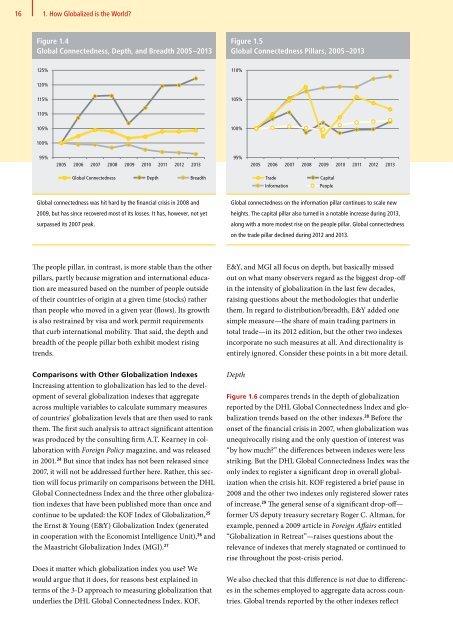DHL Global Connectedness Index 2014
DHL Global Connectedness Index 2014
DHL Global Connectedness Index 2014
- No tags were found...
Create successful ePaper yourself
Turn your PDF publications into a flip-book with our unique Google optimized e-Paper software.
16 1. How <strong>Global</strong>ized is the World<br />
Figure 1.4<br />
<strong>Global</strong> <strong>Connectedness</strong>, Depth, and Breadth 2005 –2013<br />
Figure 1.5<br />
<strong>Global</strong> <strong>Connectedness</strong> Pillars, 2005 –2013<br />
125%<br />
110%<br />
120%<br />
115%<br />
105%<br />
110%<br />
105%<br />
100%<br />
100%<br />
95%<br />
95%<br />
2005 2006 2007 2008 2009 2010 2011 2012 2013 2005 2006 2007 2008 2009 2010 2011 2012 2013<br />
<strong>Global</strong> <strong>Connectedness</strong> Depth Breadth Trade Capital<br />
Information<br />
People<br />
<strong>Global</strong> connectedness was hit hard by the financial crisis in 2008 and<br />
2009, but has since recovered most of its losses. It has, however, not yet<br />
surpassed its 2007 peak.<br />
<strong>Global</strong> connectedness on the information pillar continues to scale new<br />
heights. The capital pillar also turned in a notable increase during 2013,<br />
along with a more modest rise on the people pillar. <strong>Global</strong> connectedness<br />
on the trade pillar declined during 2012 and 2013.<br />
The people pillar, in contrast, is more stable than the other<br />
pillars, partly because migration and international education<br />
are measured based on the number of people outside<br />
of their countries of origin at a given time (stocks) rather<br />
than people who moved in a given year (flows). Its growth<br />
is also restrained by visa and work permit requirements<br />
that curb international mobility. That said, the depth and<br />
breadth of the people pillar both exhibit modest rising<br />
trends.<br />
E&Y, and MGI all focus on depth, but basically missed<br />
out on what many observers regard as the biggest drop-off<br />
in the intensity of globalization in the last few decades,<br />
raising questions about the methodologies that underlie<br />
them. In regard to distribution/breadth, E&Y added one<br />
simple measure—the share of main trading partners in<br />
total trade—in its 2012 edition, but the other two indexes<br />
incorporate no such measures at all. And directionality is<br />
entirely ignored. Consider these points in a bit more detail.<br />
Comparisons with Other <strong>Global</strong>ization <strong>Index</strong>es<br />
Increasing attention to globalization has led to the development<br />
of several globalization indexes that aggregate<br />
across multiple variables to calculate summary measures<br />
of countries’ globalization levels that are then used to rank<br />
them. The first such analysis to attract significant attention<br />
was produced by the consulting firm A.T. Kearney in collaboration<br />
with Foreign Policy magazine, and was released<br />
in 2001. 24 But since that index has not been released since<br />
2007, it will not be addressed further here. Rather, this section<br />
will focus primarily on comparisons between the <strong>DHL</strong><br />
<strong>Global</strong> <strong>Connectedness</strong> <strong>Index</strong> and the three other globalization<br />
indexes that have been published more than once and<br />
continue to be updated: the KOF <strong>Index</strong> of <strong>Global</strong>ization, 25<br />
the Ernst & Young (E&Y) <strong>Global</strong>ization <strong>Index</strong> (generated<br />
in cooperation with the Economist Intelligence Unit), 26 and<br />
the Maastricht <strong>Global</strong>ization <strong>Index</strong> (MGI). 27<br />
Does it matter which globalization index you use We<br />
would argue that it does, for reasons best explained in<br />
terms of the 3-D approach to measuring globalization that<br />
underlies the <strong>DHL</strong> <strong>Global</strong> <strong>Connectedness</strong> <strong>Index</strong>. KOF,<br />
Depth<br />
Figure 1.6 compares trends in the depth of globalization<br />
reported by the <strong>DHL</strong> <strong>Global</strong> <strong>Connectedness</strong> <strong>Index</strong> and globalization<br />
trends based on the other indexes. 28 Before the<br />
onset of the financial crisis in 2007, when globalization was<br />
unequivocally rising and the only question of interest was<br />
“by how much” the differences between indexes were less<br />
striking. But the <strong>DHL</strong> <strong>Global</strong> <strong>Connectedness</strong> <strong>Index</strong> was the<br />
only index to register a significant drop in overall globalization<br />
when the crisis hit. KOF registered a brief pause in<br />
2008 and the other two indexes only registered slower rates<br />
of increase. 29 The general sense of a significant drop-off—<br />
former US deputy treasury secretary Roger C. Altman, for<br />
example, penned a 2009 article in Foreign Affairs entitled<br />
“<strong>Global</strong>ization in Retreat”—raises questions about the<br />
relevance of indexes that merely stagnated or continued to<br />
rise throughout the post-crisis period.<br />
We also checked that this difference is not due to differences<br />
in the schemes employed to aggregate data across countries.<br />
<strong>Global</strong> trends reported by the other indexes reflect





